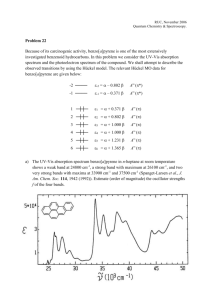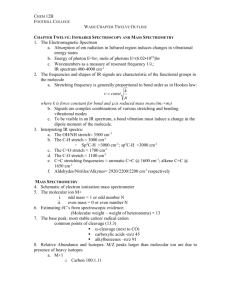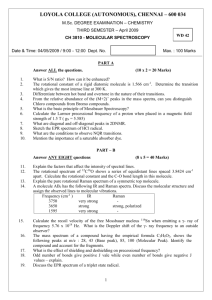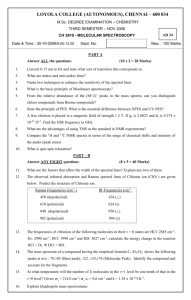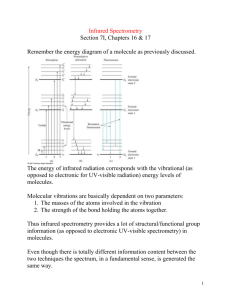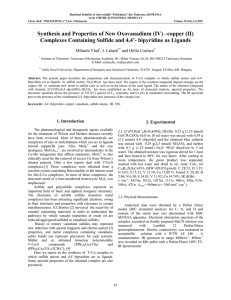IR and UV
advertisement
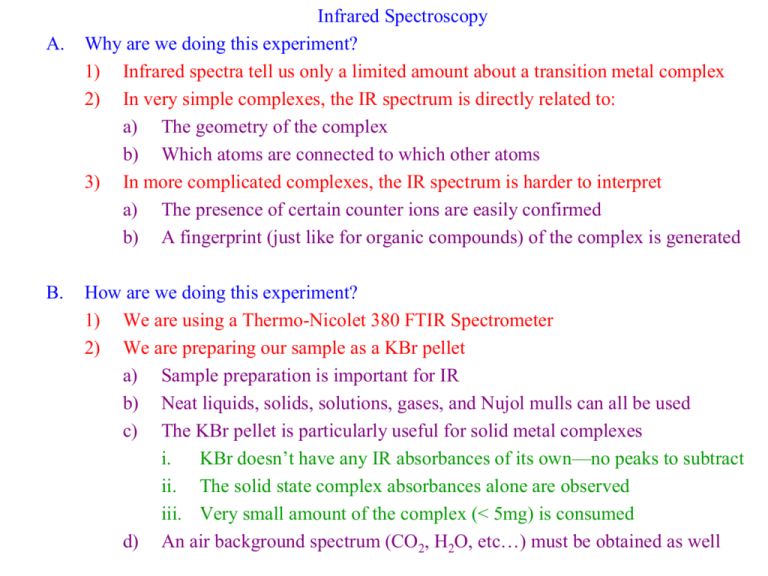
A. B. Infrared Spectroscopy Why are we doing this experiment? 1) Infrared spectra tell us only a limited amount about a transition metal complex 2) In very simple complexes, the IR spectrum is directly related to: a) The geometry of the complex b) Which atoms are connected to which other atoms 3) In more complicated complexes, the IR spectrum is harder to interpret a) The presence of certain counter ions are easily confirmed b) A fingerprint (just like for organic compounds) of the complex is generated How are we doing this experiment? 1) We are using a Thermo-Nicolet 380 FTIR Spectrometer 2) We are preparing our sample as a KBr pellet a) Sample preparation is important for IR b) Neat liquids, solids, solutions, gases, and Nujol mulls can all be used c) The KBr pellet is particularly useful for solid metal complexes i. KBr doesn’t have any IR absorbances of its own—no peaks to subtract ii. The solid state complex absorbances alone are observed iii. Very small amount of the complex (< 5mg) is consumed d) An air background spectrum (CO2, H2O, etc…) must be obtained as well absorbance IR Spectrum for [CoL][PF6] H2O C-H C=O PF6 4000.00 3500.00 3000.00 2500.00 2000.00 1500.00 1000.00 500.00 wavenumber O + N O N PF6- Co N O N O C. How do we work up the data? 1. You will save a txt file of your complex’s IR spectrum 2. You will import the files into Excel and prepare a chart of the spectrum D. How do we interpret the results? 1. You will report a list of all of the major IR peaks of your complex at the end of the synthetic description: Ex: IR (KBr pellet): 3429 cm-1, (OH); 2919 cm-1, (C–H stretches); 2361 cm-1, (C=O); 834 cm-1, (PF6). 2. You will note any assignments that can be made 3. You will provide references for your assignments UV-Visible (or Electronic) Spectroscopy A. Why are we doing this experiment? 1) The electronic spectrum provides direct evidence about the d-electrons 2) Colored complexes are colored because their d-electrons absorb visible light 3) In some cases, the electronic spectrum allows us to calculate Do directly 4) This information allows us to understand the ligand field strength of new ligands B. How are we doing this experiment? 1) We are using a Shimadzu UV-240 UV-Vis Spectrometer. 2) We are using acetonitrile solutions of our complexes C. How do we work up the data? 1. You will export an ASCII file of your complex’s UV-Vis spectrum 2. You will import the files into Excel and prepare a chart of the spectrum D. How do we interpret the results? 1. UV-Vis Spectra of metal complexes is like NMR for organic compounds a) Wavelengths and Intensities of Absorbances are characteristic of a specific complex, just like Chemical Shift, Splitting, and Integration are specific to an organic molecule b) Calculation of these values provides a test for others to use to tell if they’ve made the same complex, or if what they’ve made is pure (much like NMR) 2. Use Beer’s Law to calculate the Molar Extinction Coefficient for all of your peaks 3. The Beer-Lambert Law a) Absorbance = A = log (Io/I) Most modern systems give readings in A directly, so you don’t have to do the math. A has no unit. b) A = elc describes the absorption of light in a solution i. l = the length of the cell containing the solution, usually 1 cm ii. c = concentration in mol/L = M iii. e = Molar extinction coefficient = constant for a given molecule at a given wavelength of light = how well the molecule absorbs light ε 4. A 1 M -1cm -1 lc (cm)(M) Plotting Spectra a) E = hn c = ln = 3 x 108 m/s E b) h = 6.626 x 10-34 Js = Planck’s constant hc energy of light of wavelengt h λ λ 1 -1 Wavenumber = ν λ cm i. higher energy = larger wavenumbers ii. Higher energy = smaller wavelength 500 nm ?? cm -1 ν 1 20,000 cm -1 -7 10 cm (500nm) nm E hc hc ν λ 5) 6) You will report all of the absorptions in the following format: a. Example: lmax = 560 nm (e = 140 M-1 cm-1) b. State whether this band is a d-d transition i. Usually long lmax, small e ii. “Forbidden” by the “selection rules” so doesn’t happen easily c. Or if it is a charge transfer (ligand to metal charge transfer) band i. Usually short (UV) lmax and large e ii. “Allowed” by the “selection rules Cu2+, Co3+ and Ni2+ Octahedral complexes allow the simple calculation of Do a. You will want to compare Do for our ligands to some other ligands b. For Co3+: Do = (cm-1 of lowest energy band) + (3800 cm-1) c. For Ni2+: Do = (cm-1 of lowest energy band) d. For Cu2+: Do = (cm-1 of only d-d energy band)

